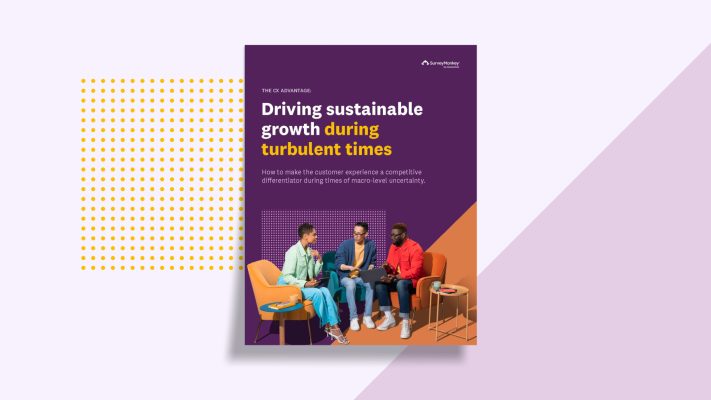Businesses have faced unprecedented challenges over the past several years, and 2023 is just as turbulent. In this climate of uncertainty, excellent customer experiences (CX) help organizations navigate the storm and stay ahead of the competition.
But creating a strong CX program that fosters customer relationships is easier said than done. Keep reading to learn how investing in three key areas can drive customer loyalty and retention, giving you a competitive edge when you need it most.
For more in-depth strategies on leveraging customer experience as a competitive differentiator, don’t miss our guide, The CX advantage: Driving sustainable growth during turbulent times.
Priority #1: Build a customer-centric culture
An organization has a customer-centric culture when all employees and leaders put the customer at the core of everything they do. Satisfaction isn’t enough. In these organizations, customer happiness is the driving force for all strategic decisions and communications, both internally and externally.
Customer-centric companies often experience the added advantage of increased retention, Customer Lifetime Value (CLV), and profitability. However, culture needs nurturing. It works best when there’s authentic communication and visibility around shared goals and outcomes.
Foster a customer-centric culture by:
- Collecting, sharing, and acting on customer feedback consistently
- Offering employee well-being programs and encouraging team leaders to support employee self-care
- Educating and empowering employees with new and creative ways to contribute to a customer-centric culture
- Recognizing essential milestones and moments along the employee journey
Empowering employees with a shared vision is key to creating a customer-centric culture. Continuing to communicate, educate, and evaluate how to live up to that vision is how to maintain and grow that culture in the present and future.
Priority #2: Cultivate strong cross-functional partnerships
A cross-functional CX program operates across business units and departments with the common goal of delivering the best customer experience possible.
With cross-functional leadership, collaboration, and operations, you’ll break down silos, work through inefficiencies, and create a cohesive and seamless experience for customers and employees.
Build strong cross-functional teams by:
- Obtaining executive buy-in and support by ensuring leadership understands how the cross-functional team contributes to the organization's strategic CX objectives
- Clearly articulating the key performance indicators (KPIs), goals, and objectives of the cross-functional team, such as improving customer satisfaction or driving retention
- Creating alignment around organizational goals, strategies, and visions
- Establishing regular meetings or collaboration spaces where teams can share KPIs, metrics, and customer insights
- Regularly analyzing your progress against set goals to assess the effectiveness of the program and pivot if necessary
Priority #3: Bolster CX at every touchpoint of the customer journey
Enhance the customer experience throughout the entire customer journey by focusing on every touchpoint a customer may have with your organization. By paying attention to these interactions, CX teams can create more positive and memorable customer experiences.
Here are some tips to bolster CX at every touchpoint.
Before a purchase
Ensure you're making it easy for customers to find the information they need to make an informed purchasing decision. Your website should provide easy navigation, transparent pricing, and high-quality product imagery.
At the time of purchase
If your checkout process is overly complex, it will likely frustrate customers, which could lead to cart abandonment or even negative reviews. When auditing your checkout experience, ensure the steps required to purchase are minimal and seamless. Provide multiple payment options to accommodate customer preferences.
Give real-time updates on the purchase status, such as order confirmation, shipping notifications, and tracking information. If any delays arise, communicate promptly and transparently.
After a purchase
Offer post-purchase support, including resources, guides, or FAQs that can help customers get the most out of their purchases. Offer assistance in setting up, using, or returning the product.
Demonstrate that you’re committed to customer satisfaction by following up with buyers after purchase to thank them and inquire about their experience. Ask about their experience and provide channels for customers to share opinions or report issues. Reward customers for their repeat business by offering incentives, discounts, or exclusive access to new products or services.
Regularly analyze customer feedback and identify areas for improvement. Use customer insights to refine your products, services, and overall customer experience. Show customers that you take their feedback seriously and that you’re committed to providing the best experience possible.
Committing to CX excellence
The customer journey is dynamic, and customers may interact with your brand across multiple touchpoints. Consistently delivering a positive and seamless experience at each stage strengthens customer relationships and increases the likelihood of repeat business and referrals—a feat made easier with empowered employees, no organizational silos, and access to real-time insights.
The CX advantage: Driving sustainable growth during turbulent times
Learn more strategies to remain competitive during these uncertain times.




